 Pass Your 2025 NJATC Aptitude Test with Accurate Practice
Pass Your 2025 NJATC Aptitude Test with Accurate Practice
The National Joint Apprenticeship and Training Committee (NJATC/JATC) Aptitude Test is a 69-question test divided into two sections:
- Algebra and Mechanical Reasoning questions (33 questions, 46 minutes) cover Functions, Polynomials, Equations, Number Series, Force and Torque, Wheels and Pulleys, Gears, Velocity, and Electricity.
- Reading Comprehension questions (36 questions, 51 minutes) will test your ability to identify the key idea of the text, analyze arguments, and understand context and vocabulary.
The time to finish the test is 97 minutes in total.
JobTestPrep's NJATC Aptitude Test practice is based on thousands of phone interviews, customer feedback, and reviews of the actual test dating back to 2016. Here’s the full practice plan:
Only candidates with the highest scores will be selected to continue the Electrical Training Alliance recruiting process, so more than just passing is required.
NJATC Practice Test Questions (Electrical Aptitude Test)
The test starts with a math section designed to prepare you for the Algebra and Functions section. The math section covers various topics, including algebra, equations, inequalities, functions, polynomials, and number series. Calculators are not allowed on the JATC aptitude test, so it's important to sharpen your basic math skills. Be sure you can quickly and accurately perform calculations such as BEDMAS, the four operations, and fractions before attempting the questions.
Math and Mechanical Section - Algebra
Algebra - Equations and Inequations
1. Choose the correct answer


Answer:
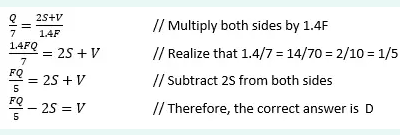
Algebra - Functions
2. Consider the following graph:
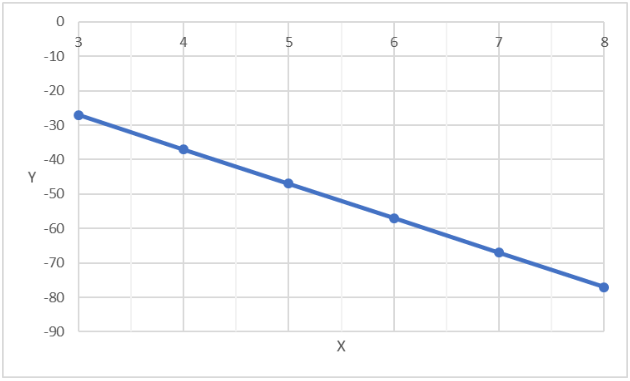
Which of the following equations best represents the graph?
A. Y=-6X+5
B. Y = 4-10
C. Y=-10X +3
D. Y=-3x+8
Answer:
The correct answer is (C).
As can be seen from the graph, the slope of the line is negative. Thus, answer (B) can be eliminated. As can also be seen from the graph, when X = 3, Y is between -20 and -30. According to answer (A), Y = -13 when X = 3. According to answer (C), Y = -27 when X = 3. According to answer (D), Y = -1 when X = 3. Thus, only answer (C) agrees with this graph.
Therefore, the correct answer is (C).
Algebra questions are challenging and require a good grasp of basic algebra rules and the skill to solve various problems by hand (no calculators allowed). There are both quick and slow methods to solve these questions. Even if you're confident in your algebra skills, you might struggle to answer within the 90-second time limit of the test.
Master the NJATC Math Test with Realistic Practice Questions!
Prepare smarter with the NJATC Practice Pack, offering:
- Test simulations that replicate the NJATC format and time constraints.
- Proven techniques to boost problem-solving speed and accuracy.
- Everything you need to feel confident and ready for the exam.
Don’t wait—start practicing today!
See What People Say About Our Prep Pack
Let’s proceed with more examples of the IBEW Math and Mechanical Section’s questions – Number Series Questions.
Math and Mechanical Section – Number Series
Number Series
4. What would be the next number in the following series?
3 1/2 | 4 | 4 1/2 | 5 | 10 | 11 | 12 | 13 | 26 | 27 1/2 | 29 | 30 1/2 | ? | ? | ? | ?
A. 13, 14
B. 15, 16
C. 7,8
D. 8,9
Answer:
The correct answer is (D) – 8, 9.
There are two ways to look at this series:
(1) This series is composed of trios of terms which advance according to the following rules:
(i) The first term equals the previous first term -2, thus: 12, 10, 8.
(ii) The second term equals the previous second term -2, thus: 13, 11, 9.
(iii) The number 14 is inserted as every third term.
(2) Another point of view:
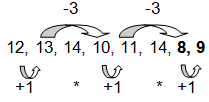
This series is composed of interdependent trios of terms which advance according to the following rules:
(1) The second term in each trio equals the first term of the trio plus 1.
(2) The third term in each trio is a constant (14).
(3) The first term in each trio equals the second term of the previous trio minus 3.
6. What would be the next number in the following series?
2 | 3 | 6 | 15 | 42 | ?
A. 84
B. 102
C. 123
D. 168
Answer:
The correct answer is (C) – 123.
The series in this question advances according to the following pattern:
(a-1)*3, a= the previous term.
Thus:
1st term = 2
2nd term = (2-1)*3 = 3
3rd term = (3-1)*3 = 6
4th term = (6-1)*3 = 15
5th term = (15-1)*3 = 42
6th term = (42-1)*3 = 123
7. What would be the next number in the following series?
5 | 10 | 20 | 24 | 48 | 96 | ? | ?
A. 100 | 200
B. 192 | 384
C. 120 | 240
D. 200 | 400
Answer:
First, identify the pattern:
- From 5 to 10: \(5 \times 2 = 10\)
- From 10 to 20: \(10 \times 2 = 20\)
- From 20 to 24: \(20 + 4 = 24\)
- From 24 to 48: \(24 \times 2 = 48\)
- From 48 to 96: \(48 \times 2 = 96\)
The pattern involves multiplying by 2 and then adding 4 alternately.
Continuing this pattern:
- From 96, we add 4: \(96 + 4 = 100\)
- From 100, we multiply by 2: \(100 \times 2 = 200\)
Therefore, the next two numbers in the series are 100 and 200.
The correct answer is: A. 100 | 200.
Tip
When working on Number Series questions, consider these steps:
- Check if the numbers are going up or down.
- Figure out how fast they are changing.
- Look for any patterns.
Tip: The more you practice different Number Series questions and patterns, the better you'll get at spotting these patterns quickly, helping you solve each question faster.
Now, let's move on to the mechanical questions, which need different and more specific knowledge. This section has fewer questions compared to the math section. Topics you might be asked about include wheels and pulleys, load distribution, balancing loads being lifted, and basic mechanical principles.
Math and Mechanical Section – Mechanics
8. On which weight does one need to exert more force in order to pull it in the direction of the arrow? If the amount of force exerted on both weights is equal please select answer option '3'.
Please select a single answer from the three options listed.
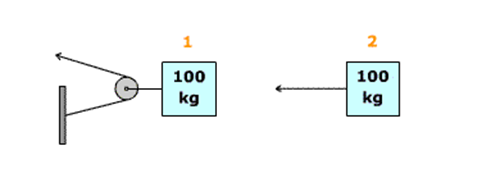
A. 1
B. 2
C. 3
Answer:
A fixed pulley provides no mechanical advantage; However, it can change the direction of the applied force.
A movable pulley does not change the direction of the force but rather allows one to use less force to lift a load. The force required to lift a load with a moveable pulley is equal to half the force required to lift the load without it.
The pulley block in Figure 1 makes the pulling easier and therefore, one should use more force to pull the weight in Figure 2.
The answer is 2
Force and Torque
9. When the following crate is pushed up the ramp, which of the following arrows describes the direction of the crate's friction?
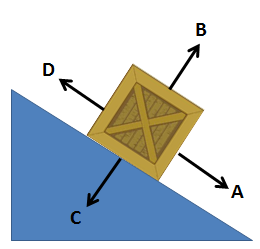
A. A
B. B
C. C
D. D
Answer:
The force of friction is always in the opposite direction to the object's movement. Thus, if the crate is pushed uphill (D), the direction of the friction will be downhill (A).
In addition, A also represents a component of the crate weight. In this case, this component acts in the opposite direction of the pushing force.
Let's review the other arrows:
(C) represents a component of the crate's weight, in the direction of gravity. Due to this force the crate adheres to the ramp's surface.
(B) represents a force called the normal force. This force is perpendicular to the surface and prevents the crate from penetrating into the surface. It is identical in size and opposite in direction to C.
The correct answer is A.
Secure Your Apprenticeship – Master the NJATC Test!
The NJATC test requires you to score in the top 4-ninths of test takers. This makes preparation essential, especially in competitive periods.
Here’s how the JobTestPrep NJATC Apprenticeship Prep helps you succeed:
- Dozens of math and mechanical practice tests.
- Detailed answers and explanations to sharpen your skills.
- Proven methods to help you rank among the top candidates.
Prepare now to secure your future and achieve your goals!
See What People Say About Our Prep Pack
For more practice, check out our Ramsay Electrical Test, the IBEW study guide, or test yourself with our free practice tests, Mechanical Aptitude Test and Pre-Apprenticeship Test.
Great job! You’ve completed the Math and Mechanical Section sample questions. Now, let's move on to the reading comprehension section.
Many candidates tend to overlook the reading comprehension part of the NJATC Apprenticeship Test because it doesn't seem as challenging as math. Don’t make that mistake. The reading section on the Electrical Aptitude test assesses your ability to extract information from a text and makes up half of your score. Make sure you prepare thoroughly for it.
Reading Comprehension Section
10. An orthopedic surgeon is preparing to perform knee replacement surgery. During the procedure, the surgeon uses several medical instruments. First, an X-ray machine is used to get a clear image of the knee's condition. Then, an arthroscope is employed to inspect the joint from the inside. Finally, a bone saw is utilized to precisely cut and shape the bones to fit the knee implant. The surgeon relies on these tools to ensure the success of the operation.
How many electrical medical instruments does the orthopedic surgeon use?
A. One
B. Two
C. Three
D. Four
Answer:
The orthopedic surgeon uses the following electrical medical instruments:
X-ray machine (used to get a clear image of the knee's condition).
Arthroscope (used to inspect the joint from the inside).
The bone saw, while a critical tool in the procedure, is not specified as an electrical medical instrument in the context provided.
Therefore, the correct answer is: B. Two.
11. Organizations today leverage data analytics to enhance decision-making processes. Data analytics can help in understanding customer preferences, predicting market trends, and optimizing operational efficiency. By analyzing large datasets, companies can gain insights into customer behavior, improve product offerings, and streamline their supply chains. Additionally, data analytics can assist in identifying areas of improvement, measuring the effectiveness of marketing campaigns, and driving overall business growth.
How can data analytics be utilized in businesses?
A. Implementing manual processes for data entry.
B. Enhancing decision-making processes through insights.
C. Ensuring employees work longer hours.
D. Reducing the need for customer feedback.
Answer:
The correct answer is (B).
Data analytics is used in businesses to gain insights from large datasets, which helps in understanding customer behavior, predicting trends, optimizing operations, and improving decision-making processes. This aligns with option B.
12. Dr. Meyer observed a fascinating phenomenon. Neutron stars, which are incredibly dense remnants of supernova explosions, emit beams of radiation from their magnetic poles. As these beams sweep across Earth, they are detected as pulses of radiation. Typically, the pulses are regular, but occasionally, neutron stars experience "glitches" that cause sudden changes in their rotational speed. These glitches are believed to be caused by shifts in the star's interior structure.
What happens to a neutron star during a glitch?
A. Its magnetic field weakens.
B. It emits a burst of light.
C. Its rotational speed changes.
D. Its temperature decreases.
Answer:
During a glitch, a neutron star experiences sudden changes in its rotational speed due to shifts in its interior structure. This phenomenon causes the pulses of radiation detected from Earth to change in frequency.
Therefore, the correct answer is: C
Master Reading Comprehension to Ace the NJATC Test!
Reading comprehension questions can be tough, but with the right strategies, you can conquer them:
- Avoid skim-reading—ask yourself questions about the text.
- Draw conclusions, identify fallacies, and summarize in your own words.
- Practice consistently to improve speed and accuracy.
The JobTestPrep NJATC PrepPack includes:
- Numerous verbal reasoning practice tests.
- Hundreds of reading comprehension questions.
- Proven strategies to help you succeed.
See What People Say About Our Prep Pack
Congrats! You've successfully finished our NJATC Free Test. Now that you're familiar with the NJATC sections, question types, and different solving techniques, it's time to start practicing and brighten your path to becoming an electrician.
FAQs
The NJATC aptitude test dates vary based on the place you submit your request to. However, here are the key scheduling points you need to remember:
You will be scheduled for the NJATC aptitude test battery after completing the initial application.
In certain places, If you do not obtain a qualifying score, you must wait between 3-6 months before retaking the test.
The NJATC aptitude test dates vary based on the place you submit your request to. However, here are the key scheduling points you need to remember:
You will be scheduled for the NJATC aptitude test battery after completing the initial application.
In certain places, If you do not obtain a qualifying score, you must wait between 3-6 months before retaking the test.
The National Joint Apprenticeship and Training Committee (NJATC) is the largest apprenticeship program in the United States for training electrical workers. Here is an overview of the NJATC apprenticeship program:
- The NJATC offers four main apprenticeship programs: inside wireman (commercial/industrial electrician), telecommunications installer, lineman, and residential electrician.
- Apprenticeships typically last 3-5 years, combining on-the-job training with classroom instruction.
- Apprentices earn wages and benefits while receiving training, typically earning $50,000-$150,000 over the course of the apprenticeship.
- On-the-job training hours range from 8,000-10,000 hours, while classroom instruction is 576-1,000 hours depending on the trade.
- Entry requirements typically include being 18 years old, having a high school diploma or GED, passing an aptitude test, and providing official transcripts.
- The NJATC apprenticeship learning model blends practical on-the-job experience with technical classroom learning to produce highly skilled electrical workers.
Although the test is commonly referred to as the NJATC Aptitude Test, the official test provider is the Electric Training Alliance, a body formed by the International Brotherhood of Electrical Workers (IBEW) and National Electrical Association (NECA) to ensure the proper training of electrician apprentices and become an electrician.
All the following test names are interchangeable: IBEW Aptitude Test, Electrical Training Alliance Aptitude Test, Electrical Aptitude Test, Electrician Apprentice Test / Electrician Pre-Apprenticeship Test.
The NJATC aptitude test is offered at various electrical training sites and may also be available from your local International Brotherhood of Electrical Workers (IBEW) union hall.
Examples of locations include Idaho, Utah, and Alaska.
You can find more locations in the following link or by typing NJATC aptitude test near me.
Yes, you can retake the test, but only after a lapse of 6 months. The Electrical Training Alliance is strict on this point, so if you take the test prior to 6 months passing after the first test, it will be disqualified.
If you come late you will be denied entry and there may be a fee for rescheduling the exam.



